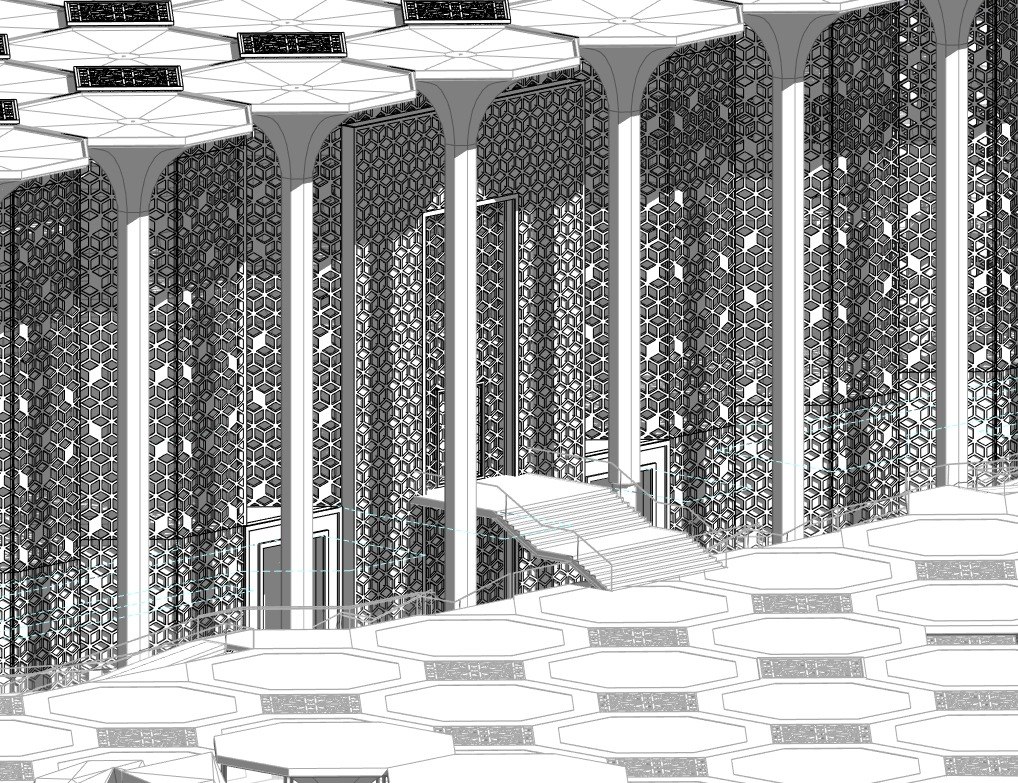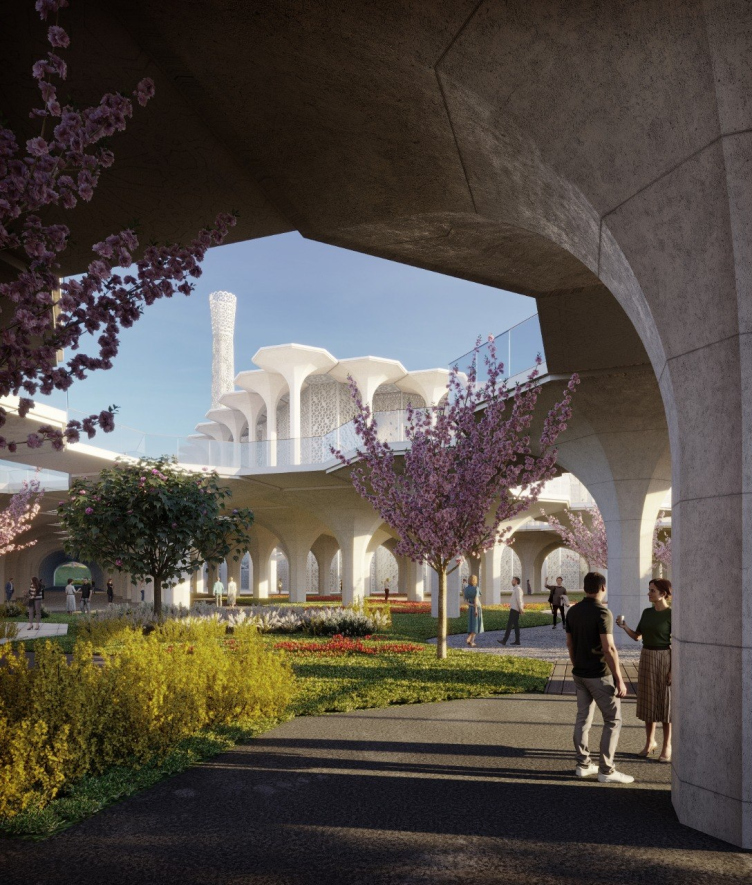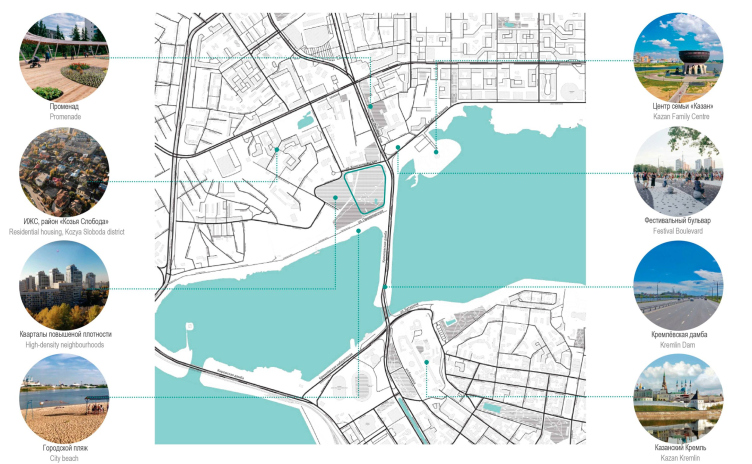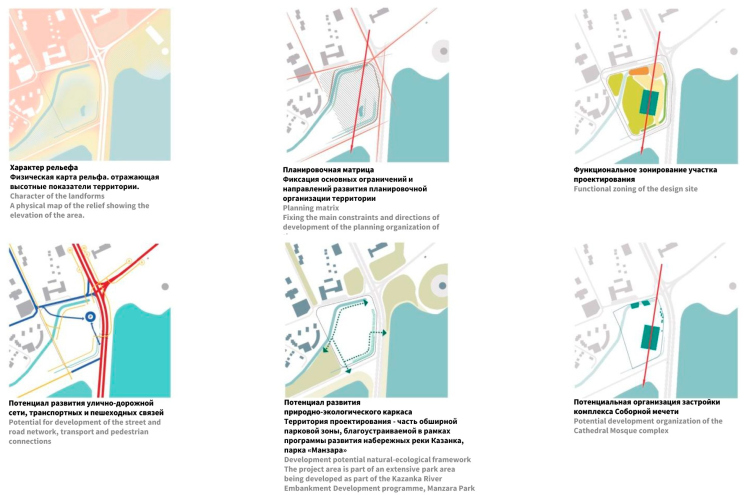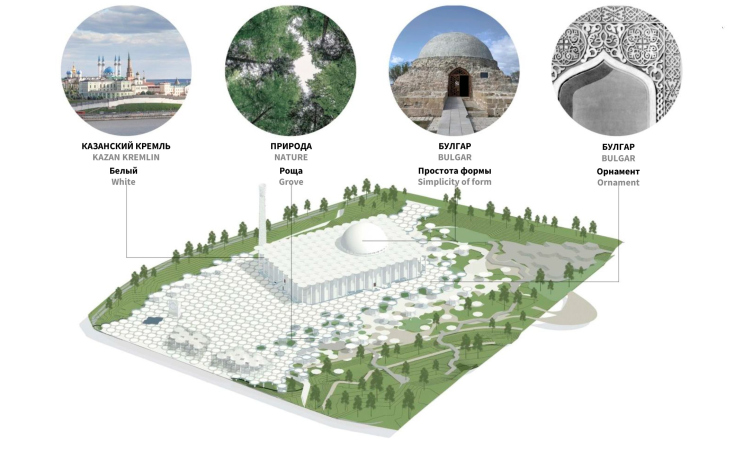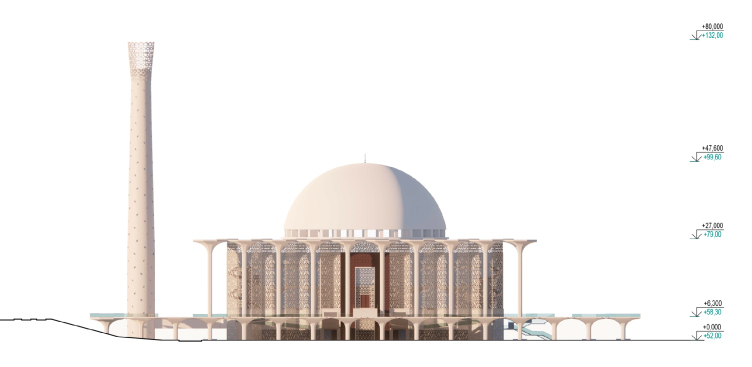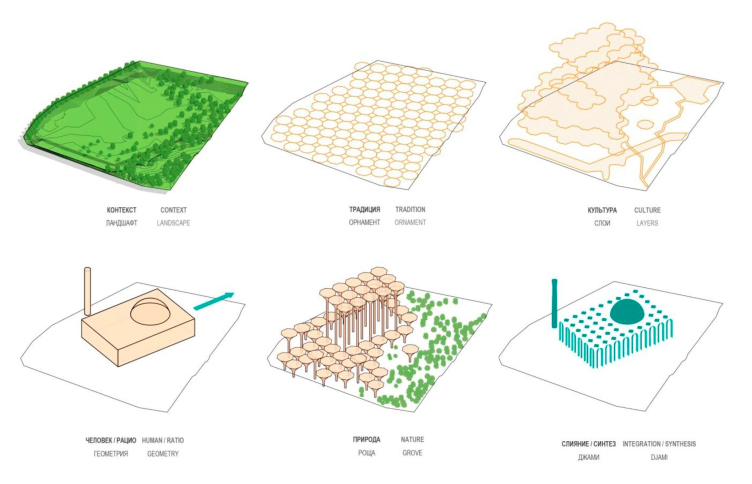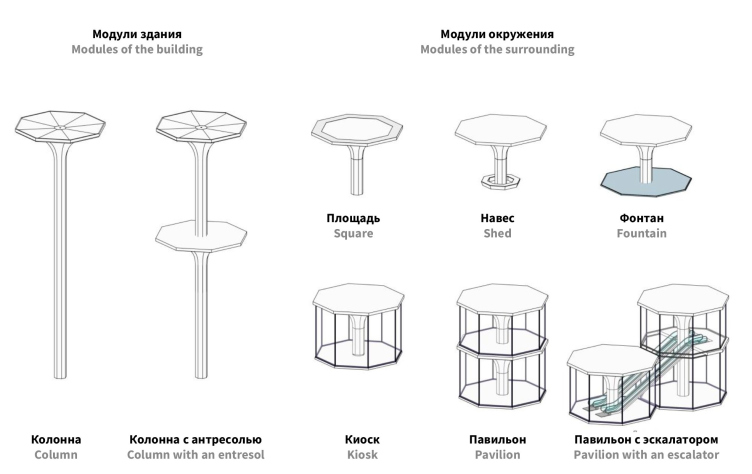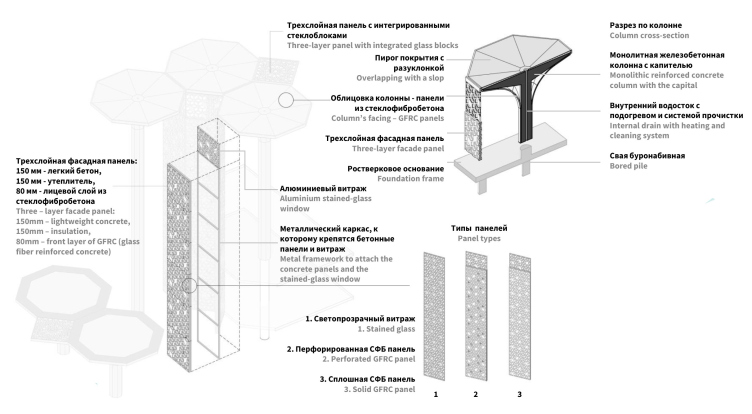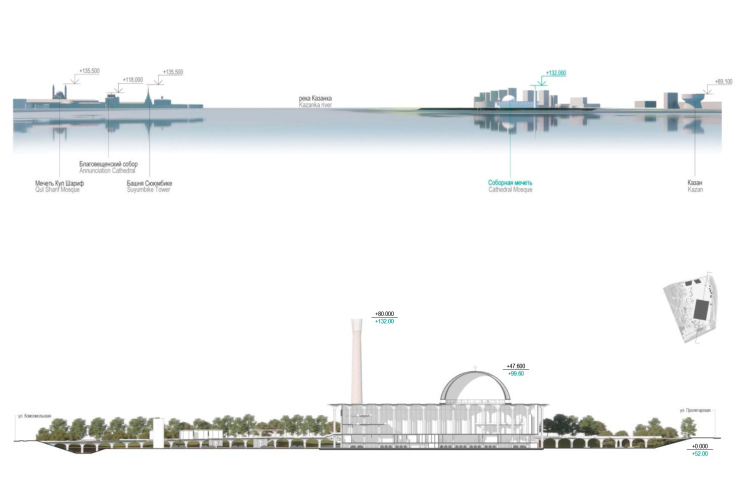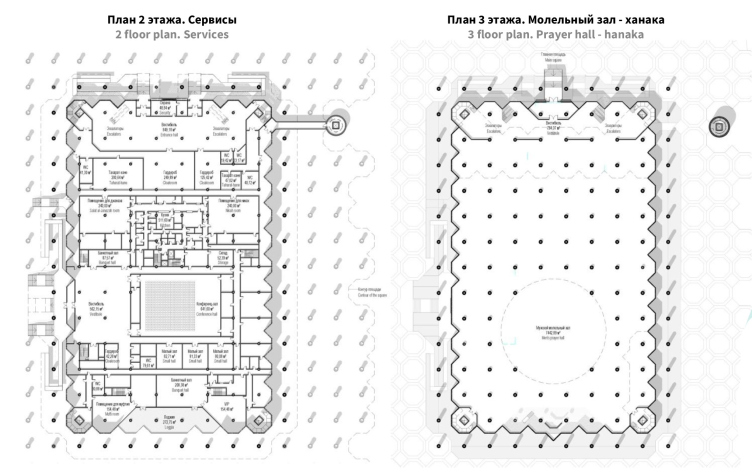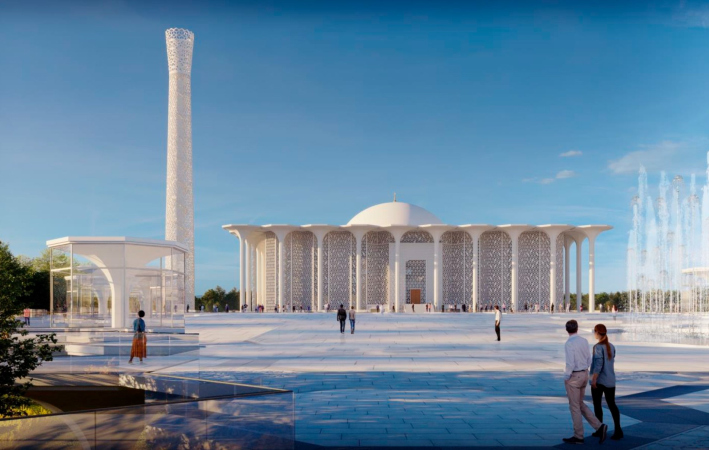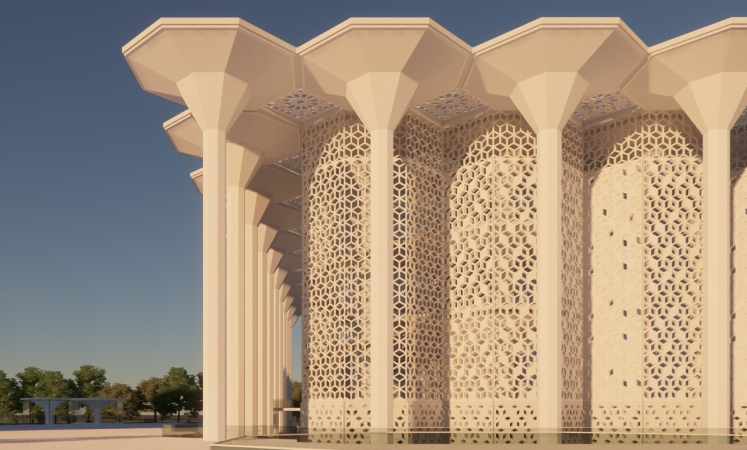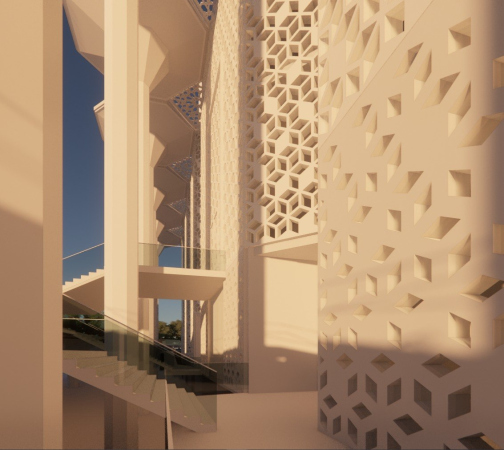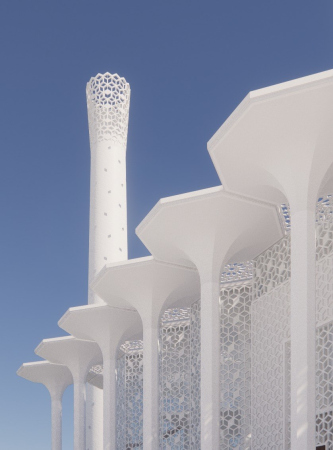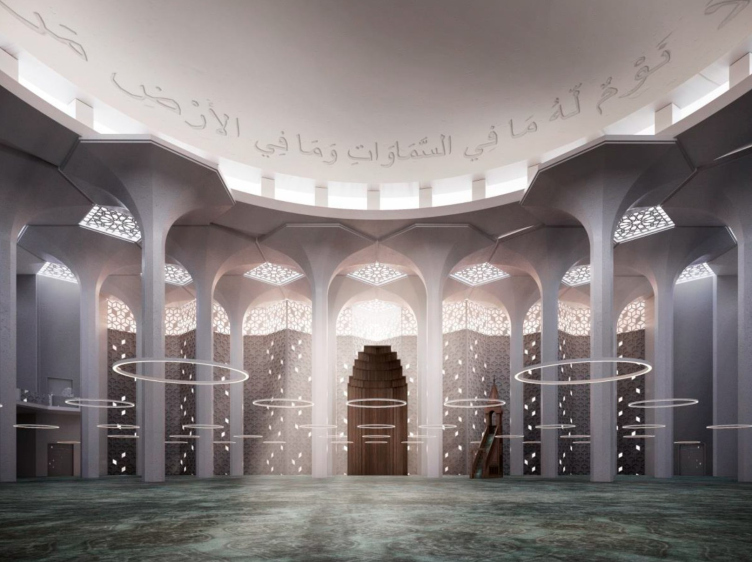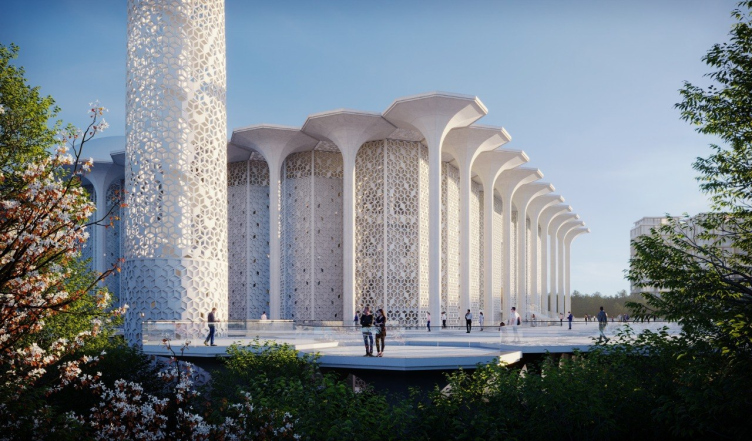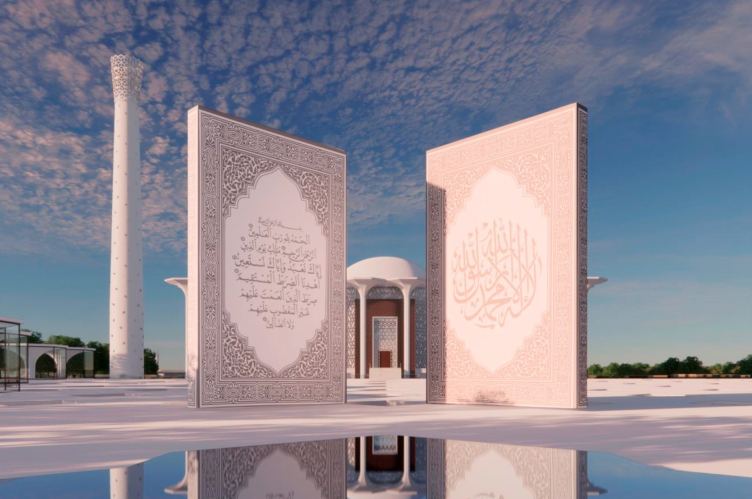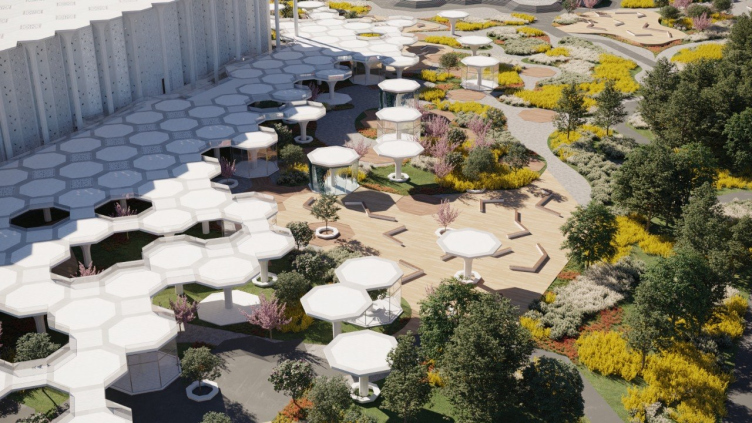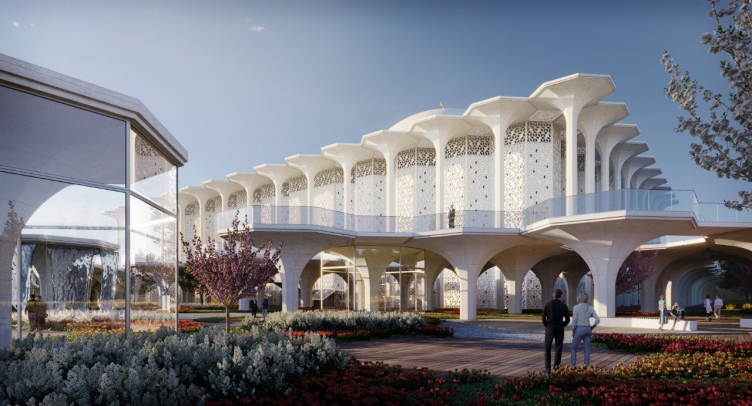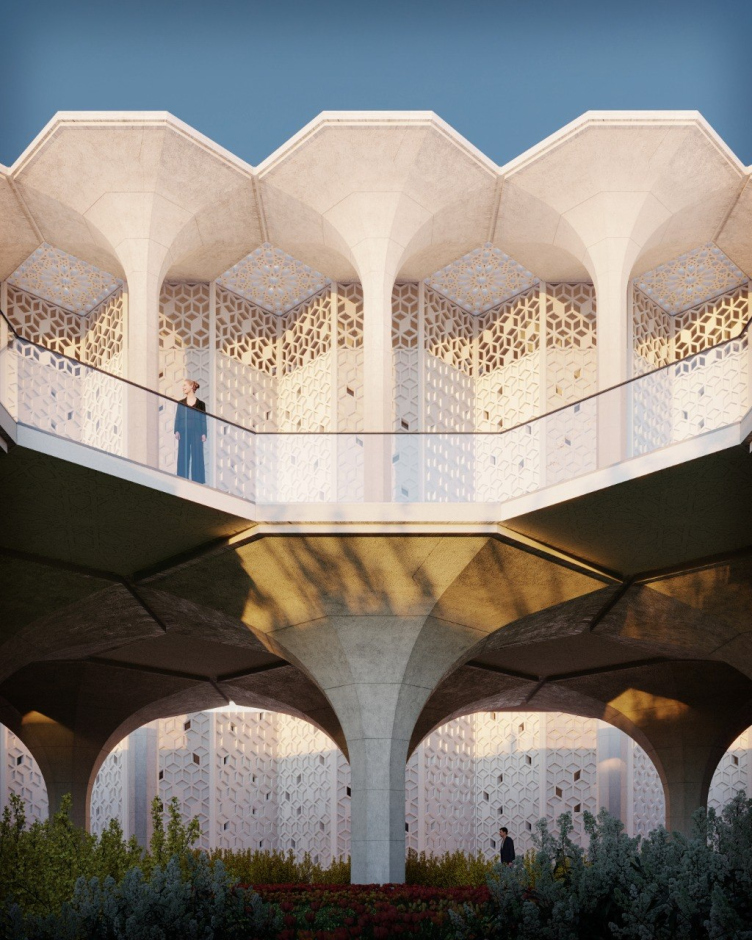The competition began in April on the eve of the first day of the holy month of Ramadan, and the winners were announced in July on the eve of the Eid al-Adha holiday. In May, the first memorial stone was laid, and construction work is planned to begin already this fall.
Preliminary design of the Cathedral Mosque in Kazan. The “concrete trees”
Copyright: © Ginzburg Architects
The Point of Convergence
The location is extremely appropriate for a grand-scale project: the site is situated on the bank of the Kazanka River opposite from the Kremlin and next to the famous wedding palace, made in the shape of a cauldron bowl. The right bank of the Kazanka River is the modern part of the city with residential buildings and industrial estates, and, at the same time, it is a walking distance away from the historical center. This location on the bank is to be seen from many vantage points in the city, it is not encumbered by any surrounding construction – formerly, this site hosted an amusement park – and possesses such assets as water and trees. The area of eight plus hectares provides enough space for the building, the park, and a sufficient amount of infrastructure.
The only limitation of the site consists in the fact that it is sunk in respect to the level of the dam and the neighboring streets by 3 to 8 meters. According to the competition specifications, the height restriction for the new building is 80 meters; also, the contestants were to take into account the proximity of the historical and architectural ensemble of the Kazan Kremlin, a UNESCO protected site.
Preliminary design of the Cathedral Mosque in Kazan. The character of the environment
Copyright: © Ginzburg Architects
The architects place the mosque on a site free of trees, orienting it along the Qibla – the direction towards the Kaaba in Mecca.
Preliminary design of the Cathedral Mosque in Kazan. Master plan
Copyright: © Ginzburg Architects
Preliminary design of the Cathedral Mosque in Kazan. The planning strategy
Copyright: © Ginzburg Architects
The Sacred Grove
The authors of the winner concept drew inspiration from the history of Islam in Volga Bulgaria – a state that once existed in the Middle Volga region and the Kama Basin in the X–XIII centuries. 150 kilometers south of Kazan, there is a surviving complex of the buildings of its ancient capital – the city of Bulgar, which is also a UNESCO-protected site. It was here that the Volga Bulgarians, the ancestors of modern Kazan Tatars, adopted Islam back in 922. Laconic and simple, these impressive monuments of architecture prompted a composition of three simple shapes: the parallelepiped of the prayer hall, the hemisphere of the dome and the truncated cone of the minaret.
Preliminary design of the Cathedral Mosque in Kazan. The inspiring images
Copyright: © Ginzburg Architects
Preliminary design of the Cathedral Mosque in Kazan. The north facade
Copyright: © Ginzburg Architects
The key image of the complex is the white grove. On the one hand, it is a reference to the origins of Islam, to the times when the faithful prayed in sacred groves, installing mihrabs in them, on the other – a tribute to the natural riches of the Volga region. White is the color of the Kazan Kremlin and the leopard of Tatarstan’s coat of arms, the color that symbolizes purity of intentions.
The mosque and the space around it are formed by “trees” – columns with eight-faceted crowns of the capitals. Essentially, these are modules, whose height depends upon the function of the specific space – the square, pavilion, fountain, or park. The tallest “trees” are linked to become the mosque itself. A similar principle can be traced in the Cathedral Mosque with a “forest of columns” in Cordoba.
Preliminary design of the Cathedral Mosque in Kazan. THe form making
Copyright: © Ginzburg Architects
Preliminary design of the Cathedral Mosque in Kazan. THe modular system
Copyright: © Ginzburg Architects
Another important part in the concept is played by the figure “8”: as the architects comment, “In Islam, the throne governing the world is supported by eight angels corresponding to the eight cardinal directions and eight groups of letters of the Arabic alphabet. In this regard, eight-pointed stars are also welcome in oriental ornaments.” The columns of the complex stand on the axes of the orthogonal grid that dissects the area around the mosque. The space between them is 922 cm, which reminds of the year Islam was adopted.
Preliminary design of the Cathedral Mosque in Kazan. The Tatarstan ornament
Copyright: © Ginzburg Architects
Preliminary design of the Cathedral Mosque in Kazan. The structure
Copyright: © Ginzburg Architects
Light and Air
As we remember, the relief of the land site looks like a giant bowl. In order to make sure that the mosque is perceived from remote vantage points as standing on the ground, the architects decided to elevate the main bulk of the building to the level of the Komsomolskaya and Dekabristov streets. Immediately in front of the mosque, there is a parking lot for 600 cars with escalators, a lobby of the second floor, and the third floor hosts the prayer hall.
Preliminary design of the Cathedral Mosque in Kazan. The city panorama / cross-section on the land site
Copyright: © Ginzburg Architects
Preliminary design of the Cathedral Mosque in Kazan. The floor plans
Copyright: © Ginzburg Architects
The walls of the mosque are executed from panels with ornament, partially filled with glass units, which makes it possible to adjust the amount of natural light inside the mosque. The north facade, where the main entrance is situated, is the most openwork and the most transparent one, through which you can see the outline of the lobby. The west and the east facades are not as transparent, and the south one has almost no openings in it since its central place is a prayer niche, a mihrab. Behind it, the architects placed two narrow windows, thanks to which a halo will appear around the mihrab on sunny days.
The hemisphere of the dome with a 20-meter radius, decorated with a calligraphic script of quotations from the Koran, is raised on special stands, so it looks as though it hovers over the prayer hall.
Preliminary design of the Cathedral Mosque in Kazan. The interior of the main hall
Copyright: © Ginzburg Architects
The height of the minaret reaches the 80 allowed meters (132 meters from the actual ground surface). Its walls are made of fiberglass and repeat the ornament of the main facades of the mosque. Towards the top, where the minaret expands in an unusual way, resembling an opening flower, the walls become ever more transparent, dissolving in the daylight and brightly lit at night. The minaret is linked to the main building with an underpass, while the staircase and the elevator make it possible to use it as a viewing platform as well.
Preliminary design of the Cathedral Mosque in Kazan. The evening lights
Copyright: © Ginzburg Architects
Preliminary design of the Cathedral Mosque in Kazan.
Copyright: © Ginzburg Architects
The Man-Made and Natural
The space in front of the mosque is divided into two parts. The minor plaza with a wide grand staircase leads people to the complex. The major plaza is intended for the congregations of worshippers on religious holidays. The two spaces are divided by monumental steles that symbolize the first printed Quran in Russia, as well as by a man made pond with a fountain.
Preliminary design of the Cathedral Mosque in Kazan. The entrance to the square
Copyright: © Ginzburg Architects
Preliminary design of the Cathedral Mosque in Kazan
Copyright: © Ginzburg Architects
The plaza, just as the roof of the mosque, is composed of large octagons – the capitals of the columns linked by punctured squares, through which natural light penetrates to the lower level of the space, where pavilions, fountains, flowerbeds, and pedestrian walks are situated, protected from rain or summer heat. The further away from the mosque, the less dense the “stone grove” becomes. Gradually, it gives way to the natural landscape of the park, which, in turn, gives way to natural forestland on the outside perimeter.
Preliminary design of the Cathedral Mosque in Kazan
Copyright: © Ginzburg Architects
Preliminary design of the Cathedral Mosque in Kazan
Copyright: © Ginzburg Architects
Preliminary design of the Cathedral Mosque in Kazan
Copyright: © Ginzburg Architects
Along the Komsomolskaya Street, where one of the main entrances to the square is situated, the public buildings form the city front. The other boundaries of the land site are formed by natural obstacles – trees, hedges, the terrain, and the Proletarskaya dam.
Preliminary design of the Cathedral Mosque in Kazan. The landscape design
Copyright: © Ginzburg Architects
The authors of the concept strived to create a space, in which the magnitude of nature and human spirit would be united. Taking roots in the ground and growing from it, the man-made space gradually converges, becoming architecture that connects people and invites them to prayer and peace in their souls.
Preliminary design of the Cathedral Mosque in Kazan. The concrete trees
Copyright: © Ginzburg Architects
We will note that on the day the results were announced, two winners were named – the other first place in the competition was scored by Kazan architect Aidar Sattarov, who proposed the project in the form of Noah’s Arc. Reportedly, the decision was made by the President of Tatarstan Rustam Minnikhanov, the state councilor of the republic Mintimer Shaimiev and the head of the Ministry of Construction Irek Fayzullin behind closed doors, and the meeting lasted for more than two hours. Now it is not very clear whether the two winning projects will be “combined” or whether just one will be ultimately chosen.
There were also two second places: the Istanbul HASSA and the Sretensky Architectural Studio from Moscow, and the third – the Kazan studio OSTA. We hope that we will be able to cover all the winners of the competition in the foreseeable future.

